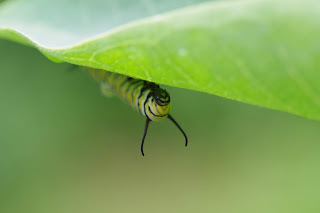My husband pointed this out to me; he spotted it yesterday. I think it is a mourning dove egg. Mourning doves have nested in the tree underneath which this was found for the last few summers, and there is what looks like a mourning dove nest up there. Their nests aren't much to speak of, almost just a small mat on a branch, so it's easy to see how an egg could fall out. Interesting that my husband found this before the storm we had last night with high winds.
The rest of the interesting eggs were insects eggs, some of them one I had already seen:
There were three of these yesterday, and now there are two. I don't know if the other one hatched, was eaten, or was washed away by the heavy rains. The missing one did look like it was ready to hatch, although there were no bugs on the leaf, and very often newly hatched bugs stick around near their hatching spot for at least a day when they emerge. I was hoping to see any hatchlings here, to find out what they are.
One of these looks ready to hatch, too. I don't think the other one was viable.
I did find some new eggs today. When I went to check on the green lacewing eggs (which have still not hatched), I found these:
They look like lady beetle eggs, though the only lady beetle eggs I have ever seen were a yellow/orange color (and I knew they were lady beetle eggs because I watched the lady beetle lay them). But it is possible that different species of lady beetles have different color eggs.
I also found this on the same leaf:
This looks like a lady beetle larva, except I don't remember if they are white when they first hatch.
Later I found this egg cluster, more lacewing eggs:
There were three of these eggs yesterday, and today there was only one.
I found several more monarch eggs:
Backyard Bug of the Day:
Cockroach. Not the kitchen invading kind, the vital part of the ecosystem, decomposer kind.
Side view, different specimen.
And now, a question: HOW IN THE WORLD DID I NOT SEE THIS BEFORE?
In the patch of milkweed on the back lawn, where I saw two milkweed tussock moth caterpillars yesterday, today I spotted TWO leaves that looked like this, absolutely COVERED in milkweed tussock moth caterpillars. There were more on this leaf before I took the picture, but I bumped the plant and a bunch of them dropped off. How in the world have I not noticed this?
There's a milkweed plant in what used to be our vegetable garden that has these:
I don't know, but they might be an earlier instar of milkweed tussock moth caterpillars. Time will tell.
There were a lot of caterpillars in the backyard today.
I keep finding more monarchs:
I saw this one in the morning when I went out with my camera for a few minutes. Note the drop of water on its back.
Several hours later, when I did my bug walk, I found that it had molted–and I think that the drop of water was still on the discarded skin. The next step for it is to turn around and eat the skin it just grew out of.
I found this one crawling on my camera.
There are still a lot of caterpillars on the black-eyed Susans.
I think this moth eclosed from that chrysalis:
There were several of them in the black-eyed Susan patch, obviously having begun as one of the species of caterpillar that has been feeding there.
This flower fly matches the flower.
Katydid nymph
Sintkbug nymph
.
.
.
.
.
.
.
.
.
.
.
.
.
Two arachnids on one flower: flower crab spider and mite
Not a spider, but spider related: This is the thing that was in the spider's web in the package bin, and it is now obvious that it is a moth, and probably a female gypsy moth.
I found some spiderlings. Some of them were on this plant...
... and some of them were on this metal stake a few feet away. There was a silk thread between them with spiders crawling on it.




































No comments:
Post a Comment